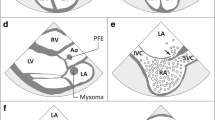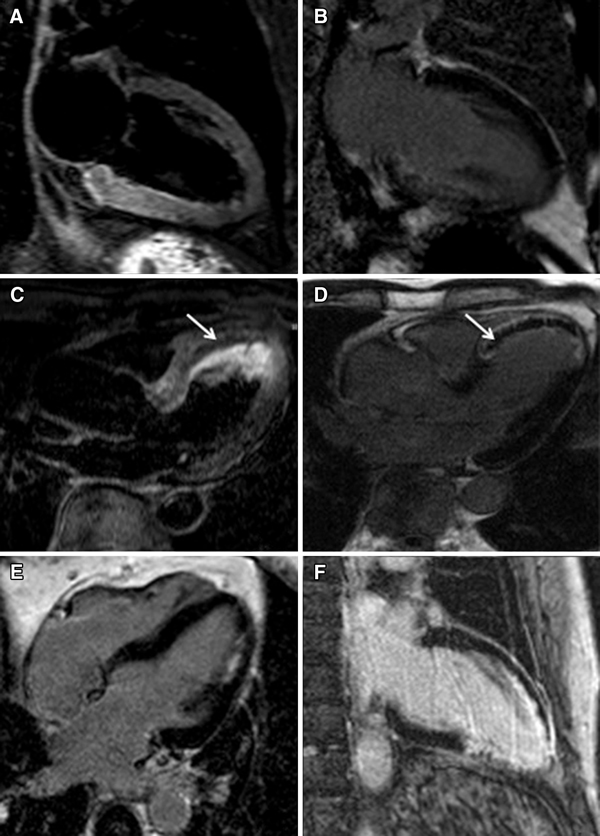Abstract
Recent advances in complementary diagnostic exams have helped to clarify stroke etiology, not only by helping to confirm established stroke causes but also by unveiling new possible stroke mechanisms. Etiological investigation for cardioembolic stroke has benefited in the last years from information provided by studies analysing serum biomarkers, heart rhythm monitoring and imaging methods like cardiovascular magnetic resonance (CMR) imaging. CMR has been particularly important for the characterization of possible new cardioembolic stroke mechanisms including atrial cardiomyopathy, silent myocardial infarction and cardiomyopathies.



Similar content being viewed by others
References
Adams HP Jr, Bendixen BH, Kappelle LJ et al (1993) Classification of subtype of acute ischemic stroke. Definitions for use in a multicenter clinical trial TOAST. Trial of Org 10172 in acute stroke treatment. Stroke 24(1):35–41. https://doi.org/10.1161/01.str.24.1.35
Amarenco P, Bogousslavsky J, Caplan LR, Donnan GA, Wolf ME, Hennerici MG (2013) The ASCOD phenotyping of ischemic stroke (Updated ASCO Phenotyping). Cerebrovasc Dis 36:1–5. https://doi.org/10.1159/000352050
Shimizu T, Kashima S, Akiyama H, Isahaya K, Hasegawa Y (2020) The ASCOD phenotyping of embolic strokes of undetermined source. J Stroke Cerebrovasc Dis 29(2):104491. https://doi.org/10.1016/j.jstrokecerebrovasdis.2019.104491
McMahon NE, Bangee M, Benedetto V et al (2020) Etiologic workup in cases of cryptogenic stroke a systematic review of international clinical practice guidelines. Stroke 51:1419–1427. https://doi.org/10.1161/strokeaha.119.027123
Hart RG, Diener HC, Coutts SB et al (2014) Embolic strokes of undetermined source: the case for a new clinical construct. Lancet Neurol 13(4):429–438. https://doi.org/10.1016/S1474-4422(13)70310-7ESUSHartetal,2014
Kim SJ, Allen JW, Bouslama M et al (2017) Carotid webs in cryptogenic ischemic strokes: a matched case-control study. J Stroke Cerebrovasc Dis 28(12):104402. https://doi.org/10.1016/j.jstrokecerebrovasdis.2019.104402
Coutinho JM, Derkatch S, Alphonse RJ, Potvin ARJ et al (2017) Carotid artery web and ischemic stroke: a case-control study. Neurology 88(1):65–69. https://doi.org/10.1212/WNL.0000000000003464
Zhang AJ, Dhruv P, Choi P et al (2018) A systematic literature review of patients with carotid web and acute ischemic stroke. Stroke 49(12):2872–2876. https://doi.org/10.1161/strokeaha.118.021907
Ntaios G, Pearce LA, Veltkamp R et al (2020) Potential embolic sources and outcomes in embolic stroke of undetermined source in the NAVIGATE-ESUS trial. Stroke 51(6):1797–1804. https://doi.org/10.1161/STROKEAHA.119.028669
Martinez-Majander RN, Ntaios G, Liu YY et al (2020) Rivaroxaban versus aspirin for secondary prevention of ischaemic stroke in patients with cancer: a subgroup analysis of the NAVIGATE ESUS randomized trial. Eur J Neurol. 27(5):841–848. https://doi.org/10.1111/ene.14172
Ntaios G, Pearce LA, Meseguer E et al (2020) Aortic arch atherosclerosis in patients with embolic stroke of undetermined source: an exploratory analysis of the NAVIGATE ESUS trial. Stroke 50(11):3184–3190. https://doi.org/10.1161/STROKEAHA.119.025813
Ameriso SF, Amarenco P, Pearce LA et al (2020) Intracranial and systemic atherosclerosis in the NAVIGATE ESUS trial: recurrent stroke risk and response to antithrombotic therapy. J Stroke Cerebrovasc Dis 29(8):104936. https://doi.org/10.1016/j.jstrokecerebrovasdis.2020.104936
Uchiyama S, Toyoda K, Kitagawa K et al (2019) Branch atheromatous disease diagnosed as embolic stroke of undetermined source: a sub-analysis of NAVIGATE ESUS. Int J Stroke 14(9):915–922. https://doi.org/10.1177/1747493019852177
Kamel H, Pearce LA, Ntaios G et al (2020) Atrial cardiopathy and nonstenosing large artery plaque in patients with embolic stroke of undetermined source. Stroke 51(3):938–943. https://doi.org/10.1161/STROKEAHA.119.028154 (PMID: 31893985)
Ntaios G, Perlepe K, Sirimarco G et al (2019) Carotid plaques and detection of atrial fibrillation in embolic stroke of undetermined source. Neurology 92(23):e2644–e2652. https://doi.org/10.1212/WNL.0000000000007611
Porambo ME, DeMarco JK (2020) MR imaging of vulnerable carotid plaque. Cardiovasc Diagn Ther. 10(4):1019–1031. https://doi.org/10.21037/cdt.2020.03.12
Mark IT, Nasr DM, Huston J et al (2020) Embolic stroke of undetermined source and carotid intraplaque hemorrhage on MRI: a systemic review and meta-analysis. Clin Neuroradiol. https://doi.org/10.1007/s00062-020-00921-2
Ospel JM, Singh N, Marko M et al (2020) Prevalence of ipsilateral nonstenotic carotid plaques on computed tomography angiography in embolic stroke of undetermined source. Stroke 51(6):1743–1749. https://doi.org/10.1161/STROKEAHA.120.029404
Siegler JE, Thon JM, Woo JH, Do D, Messé SR, Cucchiara B (2020) Prevalence of nonstenotic carotid plaque in stroke due to atrial fibrillation compared to embolic stroke of undetermined source. J Stroke Cerebrovasc Dis 28(10):104289. https://doi.org/10.1016/j.jstrokecerebrovasdis.2019.07.005
Mac Grory B, Emmer BJ, Roosendaal SD, Zagzag D, Yaghi S, Nossek E (2020) Carotid web: an occult mechanism of embolic stroke. J Neurol Neurosurg Psychiatry. https://doi.org/10.1136/jnnp-2020-323938
Kim SJ, Allen JW, Bouslama M et al (2019) Carotid webs in cryptogenic ischemic strokes: a matched case-control study. J Stroke Cerebrovasc Dis 28(12):104402. https://doi.org/10.1016/j.jstrokecerebrovasdis.2019.104402
Fonseca AC, Ferro JM (2015) Cryptogenic stroke. Eur J Neurol 22:618–623
Fonseca AC, Brito D, Pinho-e-Melo T, Geraldes R, Canhão P, Caplan LR, Ferro JM (2014) N-terminal pro-brain natriuretic peptide shows diagnostic accuracy for detecting atrial fibrillation in cryptogenic stroke patients. Int J Stroke 9:419–425
Childs H, Ma L, Ma M et al (2011) Comparison of long and short axis quantification of left ventricular volume parameters by cardiovascular magnetic resonance, with ex-vivo validation. J Cardiovasc Magn Reson 13:40
Hundley WG, Bluemke DA, Finn JP et al (2010) ACCF/ACR/AHA/NASCI/SCMR 2010 expert consensus document on cardiovascular magnetic resonance: a report of the American College of Cardiology Foundation Task Force on Expert Consensus Documents. J Am Coll Cardiol 55:2614–2662
Messroghli DR, Moon JC, Ferreira VM et al (2017) Clinical recommendations for cardiovascular magnetic resonance mapping of T1, T2, T2* and extracellular volume: a consensus statement by the Society for Cardiovascular Magnetic Resonance (SCMR) endorsed by the European Association for Cardiovascular Imaging (EACVI). J Cardiovasc Magn Reson 19:75
Bonnefoy-Cudraz E, Bueno H, Casella G, De Maria E, Fitzsimons D, Halvorsen S, Hassager C, Iakobishvili Z, Magdy A, Marandi T, Mimoso J, Parkhomenko A, Price S, Rokyta R, Roubille F, Serpytis P, Shimony A, Stepinska J, Tint D, Trendafilova E, Tubaro M, Vrints C, Walker D, Zahger D, Zima E, Zukermann R, Lettino M (2018) Editor’s choice—acute cardiovascular care association position paper on intensive cardiovascular care units: an update on their definition, structure, organisation and function. Eur Heart J Acute Cardiovasc Care 7(1):80–95
Romero J, Husain SA, Kelesidis I, Sanz J, Medina HM, Garcia MJ (2016) Detection of left atrial appendage thrombus by cardiac computed tomography in patients with atrial fibrillation: a metaanalysis. Circ Cardiovasc Imaging 6:185–194
Manning WJ, Weintraub RM, Waksmonski CA et al (1995) Accuracy of transesophageal echocardiography for identifying left atrial thrombi. A prospective, intraoperative study. Ann Intern Med 123:817–822
Groenevel I, Guglielmi V, Leeflang M et al (2020) CT angiography vs echocardiography for detection of cardiac thrombi in ischemic stroke: a systematic review and meta-analysis. J Neurol 267:1793–1801
Babu-Narayan SV, Giannakoulas G, Valente AM, Li W, Gatzoulis MA (2016) Imaging of congenital heart disease in adults. Eur Heart J 37:1182–1195
Miranda B, Fonseca AC, Ferro JM (2018) Patent foramen ovale and stroke. J Neurol 265(8):1943–1949
Silvestry FE, Cohen MS, Armsby LB et al (2015) Guidelines for the echocardiographic assessment of atrial septal defect and patent foramen ovale: from the American Society of Echocardiography and Society for Cardiac Angiography and Interventions. J Am Soc Echocardiogr 28(8):910–958
Mohrs OK, Petersen SE, Erkapic D et al (2005) Diagnosis of patent foramen ovale using contrast-enhanced dynamic MRI: a pilot study. AJR Am J Roentgenol 84:234
Fernandez RS, Diaz CM, Garcia ER, Calvo AM, Pan AR et al (2011) Atrial abnormalities: spectrum on MRI. AJR Am J Roentgenol 197:W635–W642
Weinsaft JW, Kim HW, Shah DJ et al (2008) Detection of left ventricular thrombus by delayed-enhancement cardiovascular magnetic resonance prevalence and markers in patients with systolic dysfunction. J Am Coll Cardiol 52:148–157
Srichai MB, Junor C, Rodriguez LL et al (2006) Clinical, imaging, and pathological characteristics of left ventricular thrombus: a comparison of contrast-enhanced magnetic resonance imaging, transthoracic echocardiography, and transesophageal echocardiography with surgical or pathological validation. Am Heart J 152:75–84
Baher A, Mowla A, Kodali S et al (2014) Cardiac MRI improves identification of etiology of acute ischemic stroke. Cerebrovasc Dis 37:277–284
Velangi PS, Choo C, Chen KA, Kazmirczak F, Nijjar PS, Farzaneh-Far A, Okasha O, Akçakaya M, Weinsaft JW, Shenoy C (2019) Long-term embolic outcomes after detection of left ventricular thrombus by late gadolinium enhancement cardiovascular magnetic resonance imaging: a matched cohort study. Circ Cardiovasc Imaging 12:e009723
ltbach MI, Squire SW, Kudithipudi V, Castellano L, Sorrell VL, (2007) Cardiac MRI is complementary to echocardiography in the assessment of cardiac masses. Echocardiography 24:286–300
Rosário M, Fonseca AC, Sotero FD, Ferro JM (2019) Neurological complications of cardiac tumors. Curr Neurol Neurosci Rep 19:15
Sotero FD, Rosário M, Fonseca AC, Ferro JM (2019) Neurological complications of infective endocarditis. Curr Neurol Neurosci Rep 19:23
Habib G, Lancellotti P, Antunes MJ et al (2015) 2015 ESC guidelines for the management of infective endocarditis. Eur Heart J 36:3075–3128
Dursun M, Yılmaz S, Yılmaz E et al (2015) The utility of cardiac MRI in diagnosis of infective endocarditis: preliminary results. Diagn Interv Radiol 21:28–33
Meissner I, Khandheria BK, Sheps SG et al (2004) Atherosclerosis of the aorta: risk factor, risk marker, or innocent bystander? A prospective population-based transesophageal echocardiography study. J Am Coll Cardiol 44:1018–1024
Faber T, Rippy A, Hyslop WB, Hinderliter A, Sen S (2013) Cardiovascular MRI in detection and measurement of aortic atheroma in stroke/TIA patients. J Neurol Disord 1:139
Corti R, Fuster V (2011) Imaging of atherosclerosis: magnetic resonance imaging. Eur Heart J 32:1709–1719
Kerwin WS, Miller Z, Yuan C (2017) Imaging of the high-risk carotid plaque: magnetic resonance imaging. Semin Vasc Surg 30:54–61
Kottkamp H (2013) Human atrial fibrillation substrate: towards a specific fibrotic atrial cardiomyopathy. Eur Heart J 34:2731–2738
Fonseca AC, Alves P, Inácio N, Marto JP, Viana-Baptista M, Pinho-E-Melo T, Ferro JM, Almeida AG (2018) Patients with undetermined stroke have increased atrial fibrosis: a cardiac magnetic resonance imaging study. Stroke 49(3):734–737
Tandon K, Tirschwell D, Longstreth WT Jr, Smith B, Akoum N (2019) Embolic stroke of undetermined source correlates to atrial fibrosis without atrial fibrillation. Neurology 93(4):e381–e387
Fonseca AC, Marto JP, Alves PN, Inácio N, Viana-Baptista M, Pinho E, Melo T, Ferro JM, Almeida AG (2018) Women who have ischemic strokes have a higher burden of left atrial fibrosis than men. Stroke 49:2584–2589
Habibi M, Zareian M, Ambale Venkatesh B, Samiei S, Imai M, Wu C, Launer LJ, Shea S, Gottesman RF, Heckbert SR, Bluemke DA, Lima JAC (2019) Left atrial mechanical function and incident ischemic cerebrovascular events independent of AF: insights from the MESA study. JACC Cardiovasc Imaging 12:2417–2427
Merkler AE, Sigurdsson S, Eiriksdottir G et al (2019) Association between unrecognized myocardial infarction and cerebral infarction on magnetic resonance imaging. JAMA Neurol 76:956–961
Fonseca AC, Marto JP, Pimenta D, Guimarães T, Alves PN, Inácio N, Viana-Baptista M, Pinho-E-Melo T, Pinto FJ, Ferro JM, Almeida AG (2020) Undetermined stroke genesis and hidden cardiomyopathies determined by cardiac magnetic resonance. Neurology 94:e107–e113
Hohneck A, Overhoff D, Doesch C, Sandberg R, Rudic B, Tueluemen E, Budjan J, Szabo K, Borggrefe M, Papavassiliu T (2020) Extent of late gadolinium enhancement predicts thromboembolic events in patients with hypertrophic cardiomyopathy. Circ J 84:754–762
Pöyhönen P, Kuusisto J, Järvinen V, Pirinen J, Räty H, Lehmonen L, Paakkanen R, Martinez-Majander N, Putaala J, Sinisalo J (2020) Left ventricular non-compaction as a potential source for cryptogenic ischemic stroke in the young: a case-control study. PLoS ONE 15(8):e0237228
Author information
Authors and Affiliations
Corresponding author
Ethics declarations
Conflicts of interest
Nothing to disclose.
Rights and permissions
About this article
Cite this article
Fonseca, A.C., Ferro, J.M. & Almeida, A.G. Cardiovascular magnetic resonance imaging and its role in the investigation of stroke: an update. J Neurol 268, 2597–2604 (2021). https://doi.org/10.1007/s00415-020-10393-6
Received:
Revised:
Accepted:
Published:
Issue Date:
DOI: https://doi.org/10.1007/s00415-020-10393-6




